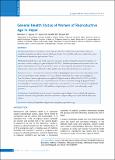Please use this identifier to cite or link to this item:
https://hdl.handle.net/20.500.14356/1782Full metadata record
| DC Field | Value | Language |
|---|---|---|
| dc.contributor.author | Bhandari, S | - |
| dc.contributor.author | Sayami, J T | - |
| dc.contributor.author | Sayami, M | - |
| dc.contributor.author | Kandel, B P | - |
| dc.contributor.author | Banjara, M R | - |
| dc.date.accessioned | 2023-05-22T09:34:15Z | - |
| dc.date.available | 2023-05-22T09:34:15Z | - |
| dc.date.issued | 2014 | - |
| dc.identifier.citation | BhandariS., SayamiJ. T., SayamiM., KandelB. P., & BanjaraM. R. (2014). General Health Status of Women of Reproductive Age in Nepal. Journal of Nepal Health Research Council. https://doi.org/10.33314/jnhrc.v0i0.428 | en_US |
| dc.identifier.issn | Print ISSN: 1727-5482; Online ISSN: 1999-6217 | - |
| dc.identifier.uri | http://103.69.126.140:8080/handle/20.500.14356/1782 | - |
| dc.description | Original Article | en_US |
| dc.description.abstract | Abstract Background: Women of reproductive age in Nepal are vulnerable to different health problems, which can jeopardize physical and mental development of fetus and mother. The aim of this study was to explore the general health status of reproductive aged women of Nepal. Methods: Household survey and health camps were conducted in selected Village Development Committees of nine districts in three ecological regions of Nepal in 2011-2012. Structured questionnaires were used to collect the required information from women of reproductive age (15 to 49 years) group. Measurement of blood pressure, anthropometry and presence of thyroid swelling, jaundice and edema of the participants were performed. Results: In total, 21111 women were interviewed. Women having hypertension (9.4%, n=85) and jaundice (0.9%, n=8) were predominant in the Mountain. Prevalence of Grade 2 thyroid (6.3%, n=320) was found higher in Terai. Prevalence of underweight women was significantly higher in women of Terai (26.6%, n=1235) (p<0.001). Prevalence of anemia was 26.0% (n=2165) in Hills and 24.7% (n=1232) in Terai. Among the pregnant women more than half were anemic and more underweight women were anemic (25.4%, n=619). Anemia was significantly associated with pregnancy (p<0.001), Hill and Terai ecological regions (p<0.001) and underweight women (p<0.001). Conclusions: General health status of women of reproductive age is still poor. Thus, such high-risk population should be the focus of the government and concerned bodies to improve the general health status of women and children. Keywords: Anemia; health problems; hypertension; pregnancy; reproductive age. | en_US |
| dc.language.iso | en | en_US |
| dc.publisher | Nepal Health Research Council | en_US |
| dc.relation.ispartofseries | Jan-April, 2014;428 | - |
| dc.subject | Anemia | en_US |
| dc.subject | Health problems | en_US |
| dc.subject | Hypertension | en_US |
| dc.subject | Pregnancy | en_US |
| dc.subject | Reproductive age | en_US |
| dc.title | General Health Status of Women of Reproductive Age in Nepal | en_US |
| dc.type | Journal Article | en_US |
| local.journal.category | Original Article | - |
| Appears in Collections: | Vol. 12 No. 1 Issue 26 Jan - Apr, 2014 | |
Files in This Item:
| File | Description | Size | Format | |
|---|---|---|---|---|
| 428-Article Text-575-1-10-20140709.pdf | Fulltext Download | 234.62 kB | Adobe PDF |  View/Open |
Items in DSpace are protected by copyright, with all rights reserved, unless otherwise indicated.
